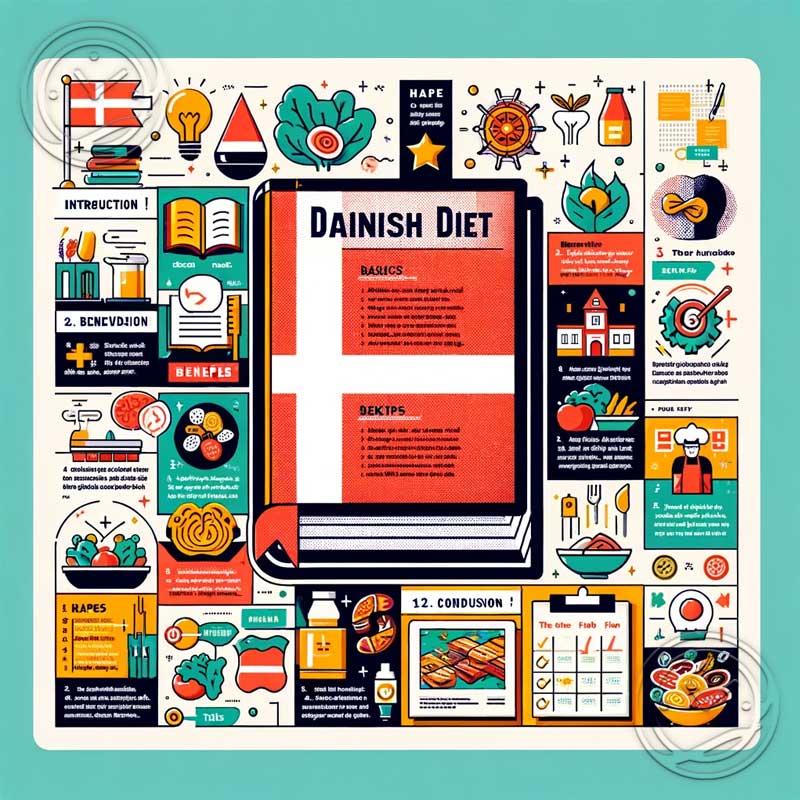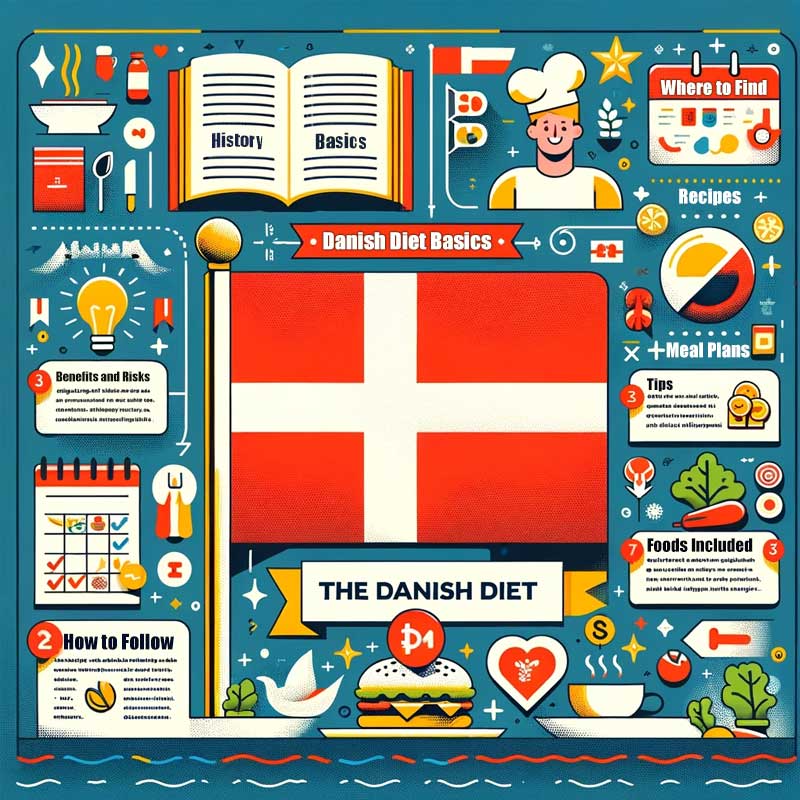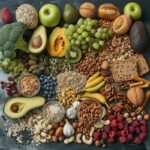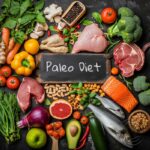Introduction
The Danish diet is a healthy and balanced diet that is rich in fruits, vegetables, whole grains, and fish. It is also low in saturated fat and cholesterol. The Danish diet has been linked to a number of health benefits, including a reduced risk of heart disease, stroke, type 2 diabetes, and some types of cancer.
The Danish diet is based on the traditional foods of Denmark, which include a lot of fresh, seasonal produce. The diet is also influenced by the country’s proximity to the sea, with a lot of seafood being eaten.
The Danish diet is a good example of a healthy diet that can be enjoyed by people of all ages. It is easy to follow and can be adapted to meet individual needs and preferences.
History
The Danish diet has a long and rich history, dating back centuries.
The traditional Danish diet is based on a few key principles:
- Abundance of fresh, local produce
- Simple, wholesome cooking
- Moderate consumption of meat
- Emphasis on seafood
These principles have been shaped by a number of factors, including the country’s geography, climate, and culture.
Denmark is a small, relatively flat country located in Northern Europe. The climate is temperate, with cold winters and mild summers. The country is home to a wide variety of crops, including grains, vegetables, fruits, and dairy products.
The Danish people have a long history of fishing and seafood has always been a staple of the Danish diet.
The traditional Danish diet is also influenced by the country’s culture. Danes are known for their love of good food and they take great pride in their culinary traditions.
The Danish diet has changed over the years, but it still retains many of its traditional elements. Today, the Danish diet is considered to be one of the healthiest in the world.
Discover the Danish Diet, a proven path to shedding pounds and enhancing your well-being. This popular weight loss regimen, inspired…
The Danish Diet Basics
The Danish diet is a healthy and balanced diet that is rich in fruits, vegetables, whole grains, and fish. It is also relatively low in saturated fat and cholesterol.
- The Danish diet is based on the Mediterranean diet, which is considered to be one of the healthiest diets in the world.
- The Danish diet is rich in fruits, vegetables, and whole grains.
- The Danish diet is relatively low in saturated fat and cholesterol.
- The Danish diet is high in fish, which is a good source of protein, omega-3 fatty acids, and other nutrients.
- The Danish diet is also high in dairy products, such as milk, cheese, and butter.
- The Danish diet is moderate in red meat and processed foods.
The Danish diet is associated with a number of health benefits, including a reduced risk of heart disease, stroke, type 2 diabetes, and some types of cancer.
The Danish diet is a healthy and balanced diet that can help you maintain a healthy weight and reduce your risk of chronic diseases.
Foods
The Danish diet is based on a variety of whole foods, including:
- Fish
- Meat
- Potatoes
- Rye bread
- Seafood
- Vegetables
- Whole grains
These foods are all rich in nutrients, and they provide the body with the energy it needs to function properly. Additionally, the Danish diet is low in processed foods and added sugars, which can help to reduce the risk of chronic diseases such as heart disease, stroke, and type 2 diabetes.
Danish Diet for Diabetes Control
Discover the Danish Diet, a powerful ally in managing diabetes and promoting overall health. Based on the wholesome traditions of…
Benefits
The Danish diet is associated with a number of health benefits, including:
- A lower risk of heart disease
- A lower risk of stroke
- A lower risk of type 2 diabetes
- A lower risk of some types of cancer
- A healthier weight
- Improved mood
- Increased energy
- Better sleep
These benefits are likely due to the fact that the Danish diet is rich in fruits, vegetables, whole grains, and fish. These foods are all packed with nutrients that are essential for good health.
The Danish diet is also relatively low in saturated fat and cholesterol, which are two factors that can increase your risk of heart disease.
Overall, the Danish diet is a healthy and balanced way of eating that can help you maintain a healthy weight and reduce your risk of chronic diseases.
Risks
While the Danish diet has many benefits, there are also some risks associated with it. These risks include:
- A high intake of saturated fat and cholesterol. The Danish diet is high in saturated fat and cholesterol, which can increase the risk of heart disease and stroke.
- A high intake of salt. The Danish diet is also high in salt, which can increase the risk of high blood pressure and stroke.
- A low intake of fruits and vegetables. The Danish diet is relatively low in fruits and vegetables, which can lead to a deficiency of vitamins and minerals.
It is important to note that these risks are associated with a high intake of Danish foods. If you eat a moderate amount of Danish foods, you can still enjoy the benefits of the diet without significantly increasing your risk of health problems.
Unlock the gateway to vibrant health with the DASH Diet Food List Guide. Imagine a life where your heart sings…
How to Follow the Danish Diet
The Danish diet is a healthy and balanced diet that is rich in fruits, vegetables, whole grains, and fish. It is also relatively low in saturated fat and cholesterol. If you are interested in following the Danish diet, here are a few tips:
- Eat plenty of fruits and vegetables.
- Choose whole grains over refined grains.
- Eat fish at least twice a week.
- Limit your intake of red meat and processed meats.
- Choose low-fat dairy products.
- Limit your intake of saturated fat and cholesterol.
- Get regular exercise.
- Maintain a healthy weight.
By following these tips, you can enjoy the benefits of the Danish diet, including a reduced risk of heart disease, stroke, type 2 diabetes, and some types of cancer.
Recipes
Here are some recipes for the Danish diet:
- Danish Pancakes
- Ingredients:
- 1 cup all-purpose flour
- 2 teaspoons baking powder
- 1/2 teaspoon sugar
- 1/2 teaspoon salt
- 1 cup milk
- 1 egg
- 1 tablespoon melted butter
- Instructions:
- In a large bowl, whisk together the flour, baking powder, sugar, and salt.
- In a separate bowl, whisk together the milk, egg, and melted butter.
- Add the wet ingredients to the dry ingredients and whisk until just combined. Do not overmix.
- Heat a lightly oiled griddle or frying pan over medium heat.
- Pour 1/4 cup of batter onto the hot griddle for each pancake.
- Cook the pancakes for 2-3 minutes per side, or until golden brown.
- Serve the pancakes with your favorite toppings, such as butter, jam, or syrup.
- Ingredients:
- Frikadeller
- Ingredients:
- 1 pound ground beef
- 1/2 cup finely chopped onion
- 1/2 cup finely chopped parsley
- 1 egg
- 1/2 cup breadcrumbs
- 1 teaspoon salt
- 1/2 teaspoon black pepper
- Instructions:
- In a large bowl, combine the ground beef, onion, parsley, egg, breadcrumbs, salt, and pepper.
- Mix until well combined.
- Form the mixture into 1-inch balls.
- Heat a large skillet over medium heat.
- Add a little oil to the skillet.
- Cook the meatballs for 5-7 minutes per side, or until browned on all sides.
- Serve the meatballs with your favorite sides, such as mashed potatoes, rice, or vegetables.
- Ingredients:
- Æbleskiver
- Ingredients:
- 1 cup all-purpose flour
- 1/2 teaspoon baking powder
- 1/2 teaspoon sugar
- 1/2 teaspoon salt
- 1 cup milk
- 1 egg
- 1 tablespoon melted butter
- Instructions:
- In a large bowl, whisk together the flour, baking powder, sugar, and salt.
- In a separate bowl, whisk together the milk, egg, and melted butter.
- Add the wet ingredients to the dry ingredients and whisk until just combined. Do not overmix.
- Heat a Æbleskiver pan over medium heat.
- Grease the pan with butter.
- Pour 1/4 cup of batter into each Æbleskiver mold.
- Cook the Æbleskiver for 2-3 minutes per side, or until golden brown.
- Serve the Æbleskiver with your favorite toppings, such as powdered sugar, whipped cream, or jam.
- Ingredients:
Meal Plans
The Danish diet is a healthy and balanced diet that is rich in fruits, vegetables, whole grains, and fish. It is also low in saturated fat and cholesterol.
There are many different ways to follow the Danish diet, but here are a few sample meal plans to get you started:
- Breakfast:
- Yogurt with berries and granola
- Oatmeal with fruit and nuts
- Whole-wheat toast with eggs and avocado
- Lunch:
- Salad with grilled chicken or fish
- Sandwich on whole-wheat bread with lean protein, vegetables, and fruit
- Soup and salad
- Dinner:
- Fish with roasted vegetables
- Chicken or pork with brown rice and vegetables
- Lentil soup with whole-wheat bread
These are just a few examples of meals that can be included in the Danish diet. You can adjust these meal plans to fit your own personal preferences and needs.
The Danish diet is a great way to improve your overall health and well-being. By following this diet, you can reduce your risk of heart disease, stroke, type 2 diabetes, and some types of cancer.

Where to Find Danish Food
Here are some tips for finding Danish food in your area:
- Look for restaurants that serve traditional Danish dishes.
- Check out grocery stores that carry Danish products.
- Order Danish food online from specialty retailers.
- Attend Danish cultural events or festivals, where you may be able to sample traditional Danish food.
If you’re unable to find Danish food in your area, you can always try making it yourself. There are many recipes available online and in cookbooks.
Here are some popular Danish dishes that you can try making at home:
- Rødgrød med fløde (red currant soup with whipped cream)
- Frikadeller (Danish meatballs)
- Smørrebrød (open-faced sandwiches)
- Æbleskiver (Danish pancakes)
- Flæskesteg (roast pork)
With a little effort, you can enjoy delicious Danish food no matter where you live.
Tips for Adopting the Danish Diet
- Start slowly. The Danish diet is a big change from many other diets, so it’s important to start slowly and gradually introduce new foods and habits.
- Make small changes. Don’t try to change everything all at once. Focus on making one or two small changes each week, and gradually increase the number of changes you make over time.
- Find support. It can be helpful to have support from friends, family, or a support group as you adopt the Danish diet.
- Be patient. It takes time to see results from the Danish diet. Don’t get discouraged if you don’t see immediate results. Just keep at it, and you will eventually see the benefits.
- Enjoy the process. The Danish diet is a healthy and sustainable way of eating. It’s important to enjoy the process and make it a part of your lifestyle.
- Eat plenty of fruits and vegetables.
- Choose whole grains over refined grains.
- Limit your intake of red meat and processed meats.
- Eat fish at least twice a week.
- Moderate your intake of alcohol.
- Make healthy swaps. There are many ways to make healthy swaps in your diet. For example, you can swap white bread for whole-wheat bread, swap sugary drinks for water or unsweetened tea, and swap fried foods for grilled or baked foods.
- Cook at home more often. When you cook at home, you have more control over the ingredients in your food. This makes it easier to make healthy choices.
- Get regular exercise. Exercise is an important part of a healthy lifestyle. It can help you burn calories, improve your cardiovascular health, and reduce your risk of chronic diseases.
- Get enough sleep. Sleep is essential for your overall health and well-being. When you don’t get enough sleep, it can affect your mood, your energy levels, and your ability to make healthy choices.
- Manage stress. Stress can take a toll on your physical and mental health. It can lead to unhealthy eating habits, weight gain, and other health problems. Find healthy ways to manage stress, such as exercise, yoga, or meditation.
Conclusion
The Danish diet is a healthy and balanced diet that is rich in fruits, vegetables, whole grains, and fish. It is also low in saturated fat and cholesterol. The Danish diet has been linked to a number of health benefits, including reduced risk of heart disease, stroke, type 2 diabetes, and some types of cancer.
If you are interested in adopting the Danish diet, there are a few things you can do. First, make sure to eat plenty of fruits, vegetables, and whole grains. Second, limit your intake of saturated fat and cholesterol. Third, choose lean protein sources, such as fish, chicken, and beans. Finally, drink plenty of water.
The Danish diet is a great way to improve your overall health and well-being. By following these simple tips, you can enjoy the benefits of the Danish diet for years to come.







